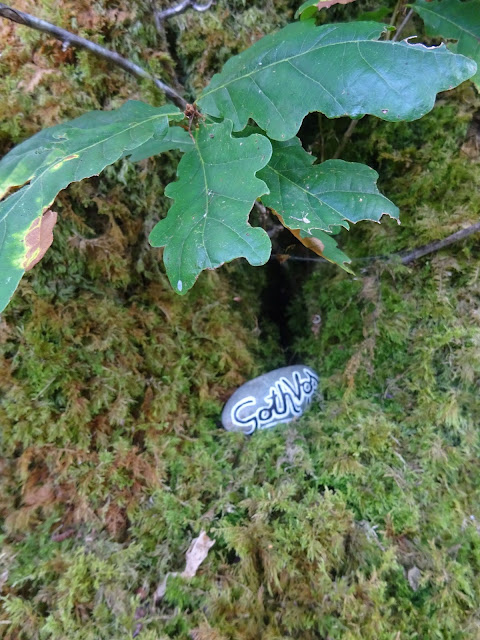23 September at 16:13 From the magical hand and eye of Julie Bowles encountering Ruskins world and connecting us to it.
23rd of September 2021, Yorkshire Dales and Lake District in September 2021 for the first time, a much needed escape following a year of Lockdown in London. Carrying my Gothvos Greenstone in my backpack over miles of hikes, passing scars, fells, forces and forests. Until the morning of my birthday, when I arrived by boat across Coniston Water to Brentwood the home of John Ruskin ; A Prophet of the 19th Century to many.
A Londoner, Ruskin moved to Brentwood on 12th September 1872. Brant originates from the Norse for "steep". The house is set in over 250 acres of woodland overlooking the visually stunning Coniston Water, including more than half a mile of lake shore laying in the shadow of the Old Man. Coincidently, Ruskin Park is close to my London home, named because Ruskin lived nearby.
During Lockdown it had been one of the green spaces I had taken a daily walk to maintain some equilibrium in all the pandemic madness.
Also coincidentally , I grew up in Oxford where Ruskin had studied, taught and founded his Drawing School before I moved to London in my early 20's. After visiting the house, the artists studio Ruskin had built for one of his relatives, I visited Ruskins Treasury. Ruskin was fascinated by mountains, minerals and geology and amassed a personal collection of over 2000 specimens in his lifetime. I like a nice fossil myself! Then I walked the steep woodland trail and gardens above the house and found a mossy home for placing my stone at the base of an Oak Tree.
 |
| Placing my Gothvos Stone at the foot of this Oak Tree gave me such a sense of peace and stillness looking out over the hills and lake below in the September sunshine, on my birthday. |
Oak is a wood favoured for its strength and durability. The technical name of the Oak, Quercus is said to be derived from the Celtic quer (fine) and cuez (tree). The Greeks held the Oak sacred, the Romans dedicated it to Jupiter and the Druids venerated it.
Artists have used its even grained, honey coloured beauty for carving and turning and it was a core part of the distinctive timbered houses. Oak's elasticity and strength made it particularly advantageous in ship building.
Edward the Confessors shrine at Westminster Abbey is of Oak that has outlasted the changes of 800 years. Oak logs have been dug from peat bogs in good preservation and fit for rough building purposes that were submerged a thousand years ago. In the Severn, breakwaters are still used as casual landing places where piles of oak are said to have been "driven in" by Romans.
The bark also yields a brown dye which was formerly used in the country to dye woollens of a purplish colour. The Scottish Highlanders used it to dye their yarns. Oak Galls gave the strong black dye from which ink was made. The bark of the tree was valued by the leather tanning industry as it contains a lot of tannin. In Brittany, tan compressed into cakes was used as fuel.
Many old British parishes contain what became known as the Gospel Oak, this was a prominent tree at which part of the Gospel was read aloud during the "beating of the bounds" - ceremonies at Rogantide in springtime, a practice supposed to have been derived from the feast to the god Terminus. When psalms and gospel truths were uttered beneath their shade and blessings asked for the people. Many of these gospel trees are still alive in different parts of Britain. In Somerset the very ancient Oaks of Avalon, Gog and Magog were named after the last male and female giants to roam Britain. The trees are reputed to be the remnants of an Oak-lined processional route up the nearby Glastonbury Tor.
The Major Oak in Sherwood Forest is purported to be the tree where Robin Hood and his merry men hatched their plots. Acorns were of considerable importance for feeding swine, in many country districts acorns are still collected up in sacks as food for Pigs.
For Herbalists the medicinal stringent effects of the Oak were well known to the ancients, by whom different parts of the tree were used. Galen applied the bruised leaves to heal wounds. The Older Herbalists considered the thin skin covering the acorn effectual in staying the spitting of blood and the powdered acorn in wine was considered a good diuretic.
A decoctation of acorns and Oak-bark with milk was considered an antidote to poisonous herbs and medicines. A Tonic derived from boiling Oak bark was used to treat harness sores of horses and it is the bark which is now employed in medicine, its action being slightly tonic, strong astringency and antiseptic. Like other astringents it has been recommended in agues and haemorrhages also it is used as a remedy in chronic diarrhoea and dysentry, externally or as a gargle in chronic sore throat.
Placing my Gothvos greenstone at the foot of this Oak Tree gave me such a sense of peace and stillness, looking out over the hills and the lakes below in the September sunshine on my birthday.
"Dearest, bury me
Under that holy-ole, or Gospel Tree
Where, though thou see'st not, thou mayst think upon
Me, when you yearly go'st Procession.
Julie's Greenstone came from the sunken Oak Forests of Gwavas Lake, Penlee. Muer Ras Julie.



No comments:
Post a Comment